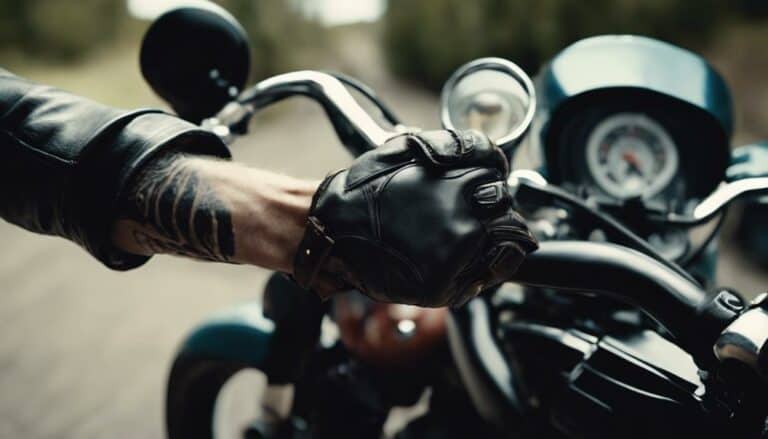When faced with a Harley Davidson that won't start, the solution might be simpler than you think.
To jumpstart your bike effectively, you need to follow a few key steps. The process involves using the right tools and ensuring a proper connection, but there's one crucial aspect that many overlook which could make all the difference in getting your Harley back on the road.
Key Takeaways
- Position bike securely and gather necessary tools for jumpstarting.
- Connect jumper cables correctly to avoid sparks and ensure stability.
- Follow steps to jumpstart engine safely and troubleshoot common issues.
- Prioritize safety measures, wear protective gear, and consider carrying a portable jump starter.
Preparing Your Harley Davidson
Before jumpstarting your Harley Davidson, ensure that it's securely positioned in a spacious area and that all necessary safety precautions have been taken. To kick off the process, identify the battery on your Harley. Typically, the battery is located beneath the seat or side panels.
Next, conduct a thorough inspection of the battery connections. Check for any visible signs of damage, corrosion, or loose connections. It's crucial to ensure that the terminals are clean and tightly secured to avoid any potential hazards during the jumpstarting procedure.
Inspect both the positive and negative terminals for any irregularities. If you notice any issues with the connections, address them promptly before proceeding further. By paying close attention to the battery and its connections, you're setting the stage for a successful jumpstarting experience. This meticulous approach not only ensures your safety but also enhances the overall performance of your Harley Davidson.
Gathering the Necessary Tools
To ensure a successful jumpstarting process for your Harley Davidson, the first step is gathering the necessary tools, including a jump box or jumper cables, to facilitate the procedure effectively. Battery maintenance is crucial, so make sure your battery is in good condition and the terminals are accessible for connection. Being prepared for emergencies is key, so have a set of tools handy in case you need to access the starter directly for jump starting.
Before beginning the jumpstarting process, check the battery and cables for any signs of damage or corrosion. Understanding the battery connections and proper jump starting procedures for a Harley Davidson is essential for a safe and successful jump start. By having the right tools and being well-prepared, you can confidently tackle jumpstarting your Harley Davidson whenever the need arises.
Connecting the Jumper Cables
When jumpstarting a Harley Davidson, ensure that the positive (red) cable is securely attached to the positive terminal on the dead battery. This connection is crucial for initiating the flow of power from the live battery to the dead one. Battery maintenance plays a significant role in ensuring your Harley starts smoothly. By correctly connecting the jumper cables, you're taking a step towards maintaining your battery's health and longevity.
Emergency procedures dictate that the negative (black) cable should be connected to a suitable ground on your motorcycle, such as the frame, away from the dead battery. Avoid attaching the negative cable directly to the negative terminal of the dead battery to prevent sparks near the battery, which could be dangerous. It's essential to double-check all connections to guarantee a stable electrical connection before attempting to start your motorcycle. By following these steps, you pave the way for a successful jumpstart without any electrical issues or damage.
Jumpstarting the Engine
After ensuring the jumper cables are correctly connected, the next step in jumpstarting your Harley Davidson is to ignite the engine using the appropriate procedure. To successfully jumpstart the engine, follow these steps:
| Steps to Jumpstart the Engine | Description |
|---|---|
| 1. Turn the Ignition Key | Insert the key and turn it to the ON position. |
| 2. Engage the Clutch | Pull the clutch lever in to disengage the transmission. |
| 3. Press the Start Button | Press the start button to crank the engine and start the bike. |
Troubleshooting common issues during engine jumpstarting may include checking the battery connections, ensuring proper cable attachment, and confirming the battery's condition. To avoid such issues, incorporate preventive maintenance strategies like regular battery checks, keeping the terminals clean, and using a trickle charger when the bike is not in use. By following these steps and strategies, you can ensure a smooth jumpstart process for your Harley Davidson, keeping you on the road without interruptions.
Safety Measures and Additional Tips
For enhanced safety and optimal performance, prioritize wearing protective gear such as gloves and safety glasses while jumpstarting your Harley Davidson. Ensuring your safety is paramount as you troubleshoot any issues with jumpstarting your bike.
Here are some safety precautions and maintenance tips to keep in mind:
- Inspect Battery Terminals: Before jumpstarting, check the battery terminals for corrosion or damage. A secure connection is vital for a safe jumpstart.
- Avoid Over-Revving: After jumpstarting your Harley, refrain from excessively revving the engine. This precaution will prevent any potential damage to the electrical system of your bike.
- Consider Portable Jump Starters: To liberate yourself from relying on external sources for jumpstarting, carry a portable jump starter with you. This compact device can be a lifesaver in emergency situations.
Conclusion
You've successfully jumpstarted your Harley Davidson, just like a skilled mechanic reviving a sleeping giant.
Remember to always follow safety precautions and properly connect the cables to avoid any mishaps.
With the right tools and knowledge, you can get back on the road in no time.
Keep your bike running smoothly and enjoy the ride!

